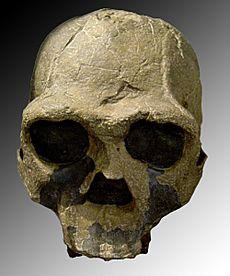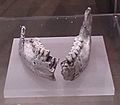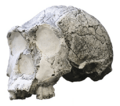Homo ergaster facts for kids
Quick facts for kids Homo ergaster |
|
|---|---|
 |
|
| Skull KNM-ER 3733, the Koobi Fora fossil discovered in Kenya, 1975 | |
| Scientific classification | |
| Kingdom: | |
| Phylum: | |
| Class: | |
| Order: | |
| Family: | |
| Genus: | |
| Species: |
H. ergaster
|
| Binomial name | |
| †Homo ergaster Groves and Mazák, 1975
|
|
Homo ergaster, sometimes called "African Homo erectus", was an early type of human that is now extinct. They lived in eastern and southern Africa a very long time ago, between 1.8 million and 1.3 million years ago. This was during a period called the early Pleistocene epoch.
Contents
Who Were Homo Ergaster?
Homo ergaster is one of the earliest members of the human family tree, known as the genus Homo. Scientists are still discussing exactly how they fit in. Many believe H. ergaster was a direct ancestor to later human types. These include Asian Homo erectus, Neanderthals (Homo neanderthalensis), and even modern humans (Homo sapiens). Some experts think H. ergaster was simply the African version of Homo erectus. Homo erectus was the first human species to spread out of Africa.
What Does Their Name Mean?
The name ergaster means "workman" in Latin. This name was chosen because Homo ergaster developed advanced stone tools. These tools are part of what is called the Acheulean tool industry. The most famous tool they made was the hand axe.
Where Did They Live?
Homo ergaster lived in eastern and southern Africa. Their time on Earth happened during the first part of the Pleistocene epoch. This was a period when the Earth's climate became much cooler. It was also the start of the ice ages.
These big climate changes affected the land in Africa. The large rainforests began to shrink. At the same time, wide open savannahs and open forests grew larger. Homo ergaster was well-suited to live in these new, more open environments.
Images for kids
-
Replica of KNM ER 992, the holotype specimen of Homo ergaster
-
KNM-WT 15000 ("Turkana Boy"), a 7 to 12 year old Homo ergaster
-
Drawing of a hand holding a hand axe
See also
 In Spanish: Homo ergaster para niños
In Spanish: Homo ergaster para niños







